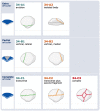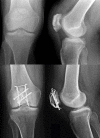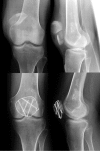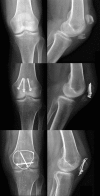Current concepts review: Fractures of the patella
- PMID: 26816667
- PMCID: PMC4717300
- DOI: 10.3205/iprs000080
Current concepts review: Fractures of the patella
Abstract
Fractures of the patella account for about 1% of all skeletal injuries and can lead to profound impairment due to its crucial function in the extensor mechanism of the knee. Diagnosis is based on the injury mechanism, physical examination and radiological findings. While the clinical diagnosis is often distinct, there are numerous treatment options available. The type of treatment as well as the optimum timing of surgical intervention depends on the underlying fracture type, the associated soft tissue damage, patient factors (i.e. age, bone quality, activity level and compliance) and the stability of the extensor mechanism. Regardless of the treatment method an early rehabilitation is recommended in order to avoid contractures of the knee joint capsule and cartilage degeneration. For non-displaced and dislocated non-comminuted transverse patellar fractures (2-part) modified anterior tension band wiring is the treatment of choice and can be combined - due to its biomechanical superiority - with cannulated screw fixation. In severe comminuted fractures, open reduction and fixation with small fragment screws or new angular stable plates for anatomic restoration of the retropatellar surface and extension mechanism results in best outcome. Additional circular cerclage wiring using either typical metal cerclage wires or resorbable PDS/non-resorbable FiberWires increases fixation stability and decreases risk for re-dislocation. Distal avulsion fractures should be fixed with small fragment screws and should be protected by a transtibial McLaughlin cerclage. Partial or complete patellectomy should be regarded only as a very rare salvage operation due to its severe functional impairment.
Obwohl Patellafrakturen lediglich für ca. 1% aller knöchernen Verletzungen verantwortlich sind, können sie – aufgrund ihrer Bedeutung für den Streckapparat – zu ausgeprägten Funktionseinschränkungen führen. Die Diagnose wird in Zusammenschau des Unfallmechanismus sowie der klinischen und radiologischen Untersuchung gestellt. Auch wenn sich auf diese Weise die Mehrzahl der Frakturen nachweisen lässte, steht dieser eine Vielzahl unterschiedlicher Behandlungsmethoden gegenüber. Die Auswahl hängt vom Frakturtyp, Weichteilschaden, individuellen Patientencharakteristika (z.B. Alter, Knochenqualität, Aktivitätsniveau und Compliance) und der Integrität des Streckapparates ab. Ziel jeder Behandlung muss es sein, eine frühfunktionelle Nachbehandlung zu ermöglichen, um Folgeschäden wie Bewegungseinschränkungen zu minimieren.Die modifizierte Zuggurtungsosteosynthese ist mittlerweile Methode der Wahl und kann – aufgrund ihrer biomechanischen Überlegenheit – mit einer kannülierten Schraubenosteosynthese kombiniert werden. Bei Trümmerfrakturen sollte zudem eine Refixation der einzelnen Fragmente mittels Kleinfragmentschrauben angestrebt werden. Die zusätzliche Anlage einer Tonnencerclage, entweder als Drahtcerclage oder als resorbierbare PDS- bzw. nicht-resorbierbare FiberWire-Cerclage erhöht die Konstruktstabilität und verringert das Risiko einer Re-Dislokation. Distale Patellafrakturen bzw. Avulsionsfrakturen der Patellasehne sollten mittels Kleinfragmentschrauben refixiert werden und zusätzlich durch eine McLaughlin-Cerclage gesichert werden. Eine partielle oder komplette Entfernung der Patella sollte – augrund der einheitlich schlechten Ergebnisse – unbedingt vermieden werden.
Keywords: biomechanics; conservative treatment; patellar fracture; patellectomy; tension band.
Figures






References
-
- Anand S, Hahnel JC, Giannoudis PV. Open patellar fractures: high energy injuries with a poor outcome? Injury. 2008 Apr;39(4):480–484. doi: 10.1016/j.injury.2007.10.032. Available from: http://dx.doi.org/10.1016/j.injury.2007.10.032. - DOI - DOI - PubMed
-
- Bellemans J, Steenwerckx A, Brabants K, Victor J, Lammens J, Fabry G. The Judet quadricepsplasty: a retrospective analysis of 16 cases. Acta Orthop Belg. 1996 Jun;62(2):79–82. - PubMed
-
- Benjamin J, Bried J, Dohm M, McMurtry M. Biomechanical evaluation of various forms of fixation of transverse patellar fractures. J Orthop Trauma. 1987;1(3):219–222. doi: 10.1097/00005131-198701030-00004. Available from: http://dx.doi.org/10.1097/00005131-198701030-00004. - DOI - DOI - PubMed
-
- Bentley G, Biant LC, Carrington RW, Akmal M, Goldberg A, Williams AM, Skinner JA, Pringle J. A prospective, randomised comparison of autologous chondrocyte implantation versus mosaicplasty for osteochondral defects in the knee. J Bone Joint Surg Br. 2003 Mar;85(2):223–230. doi: 10.1302/0301-620X.85B2.13543. Available from: http://dx.doi.org/10.1302/0301-620X.85B2.13543. - DOI - DOI - PubMed
-
- Berg EE. Management of patella fractures associated with central third bone-patella tendon-bone autograft ACL reconstructions. Arthroscopy. 1996 Dec;12(6):756–759. doi: 10.1016/S0749-8063(96)90184-X. Available from: http://dx.doi.org/10.1016/S0749-8063(96)90184-X. - DOI - DOI - PubMed
Publication types
LinkOut - more resources
Full Text Sources
Medical
Miscellaneous

